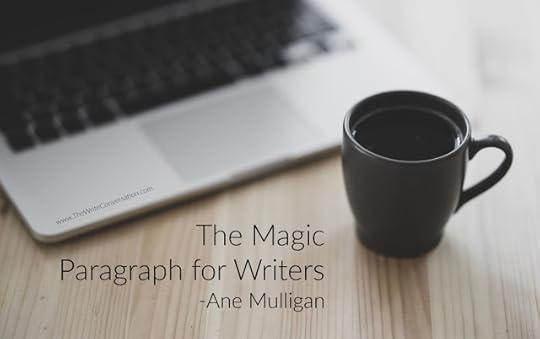The Magic Paragraph for Writers

by Ane Mulligan @AneMulligan
The late Ron Benrey taught me—and many other writers—one of the best literary devices for grounding our readers in our stories. He called it "The Magic Paragraph." It plays a weighty role in my writing and is a basic in my toolbox. So much so, Ron's wife and my first literary agent, Janet Benrey, gave me permission to carry on the teaching. And sometimes, it's good to go back to the basics. So let's dive into this device:The Magic Paragraph:Signal which head to enterWrite an appropriate sense, emotion or mental facultyShow appropriate action or responseRepeat if necessary
Breaking that down, the first one is fairly self-explanatory. Begin by letting the reader know whose POV: Jane plopped her backside down on the curb.
We know we’re in Jane’s head. You don’t have to start with the name, but give it fairly soon, so the reader knows who it is. In one of my books, I started it this way:The morning fog was about as thick as the pea soup Great-aunt Lola used to make. Claire hated that soup then and she didn’t much like this fog now.
I give you Claire’s name in the second sentence. And the reader wouldn’t confuse the POV character with Great-aunt Lola, because she wouldn’t think of her soup in that way. In the Claire example above, I have both the first and second bullets of the magic paragraph in those two opening sentences. I signaled whose head to enter and then I recorded an appropriate sense, emotion or mental faculty for the character.
Here’s step 2 to follow Jane’s opening line:Her spirit was so low she could probably dangle her feet and not touch the water trickling in the gutter.
Next is to show an appropriate action: For Claire it’s: She swished her hand back and forth in an impotent attempt to dispel it. For Jane: She pulled a crumpled tissue from her pocket and blew her nose, wishing she could blow away her problems as easily.
The last item is Repeat if necessary. We need to keep the reader grounded in our POV character’s head. This little gadget, the Magic Paragraph, isn’t a formula per se. Remember, it’s a guide to keep our readers grounded and showing what’s in our character’s head. It will serve us well and take our readers on the journey with us, making them privy to our POV character’s innermost thoughts.
Jane plopped her backside down on the curb. Her spirit was so low she could probably dangle her feet and not touch the water trickling in the gutter. She pulled a crumpled tissue from her pocket and blew her nose, wishing she could blow away her problems as easily.
So there you have it, The Magic Paragraph. Use it to help keep your story and your reader grounded in your character’s POV.
Do you have a basic tool that you keep foremost in your mind when writing? Do share, please!
TWEETABLE
The Magic Paragraph for Writers - @AneMulligan on @EdieMelson (Click to Tweet)
 Ane Mulligan has been a voracious reader ever since her mom instilled within her a love of reading at age three, escaping into worlds otherwise unknown. But when Ane saw Mary Martin in PETER PAN, she was struck with a fever from which she never recovered—stage fever. She submerged herself in drama through high school and college. Years later, her two loves collided, and a bestselling, award-winning novelist emerged. She resides in Sugar Hill, GA, with her artist husband and a rascally Rottweiler. Find Ane on her website, Amazon Author page, Facebook, Twitter, Instagram, Pinterest and The Write Conversation.
Ane Mulligan has been a voracious reader ever since her mom instilled within her a love of reading at age three, escaping into worlds otherwise unknown. But when Ane saw Mary Martin in PETER PAN, she was struck with a fever from which she never recovered—stage fever. She submerged herself in drama through high school and college. Years later, her two loves collided, and a bestselling, award-winning novelist emerged. She resides in Sugar Hill, GA, with her artist husband and a rascally Rottweiler. Find Ane on her website, Amazon Author page, Facebook, Twitter, Instagram, Pinterest and The Write Conversation.
Published on May 24, 2020 22:00
No comments have been added yet.



